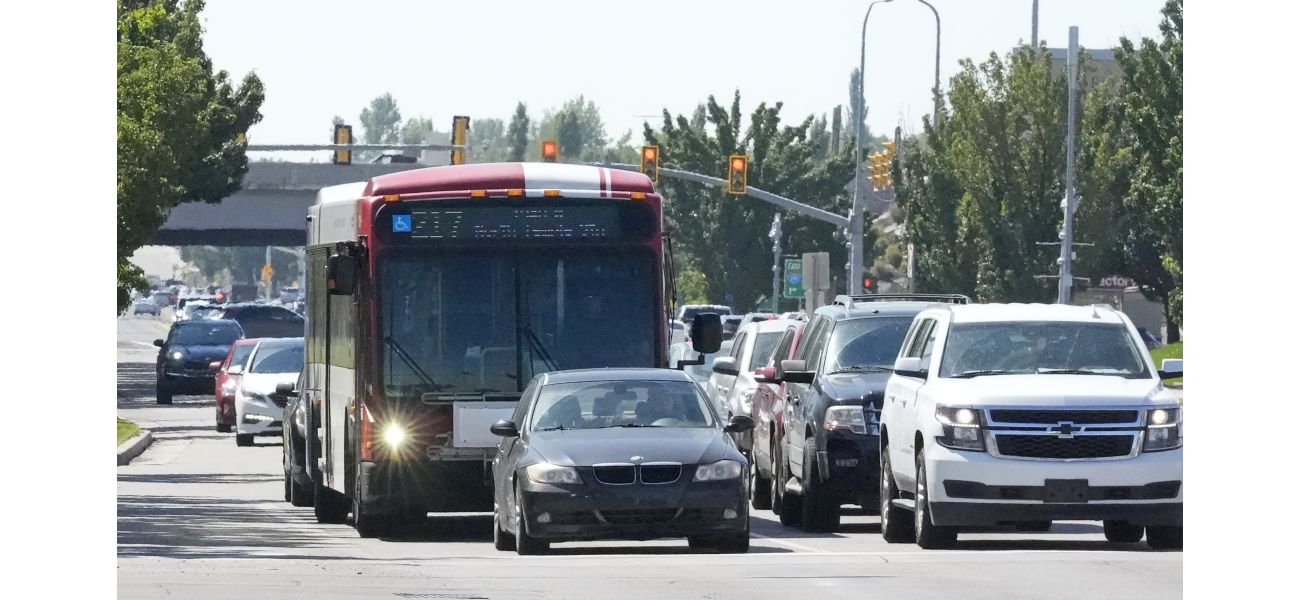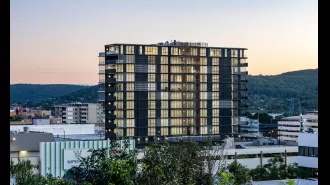Cars gather lots of information on traffic and road dangers. Should they distribute it?
Traffic on "smart streets" in Utah is improving, but it's just a glimpse of the advanced changes that could be implemented on roads nationwide.
September 14th 2024.

According to Jeff McMurray of the Associated Press, navigating through rush hour traffic in Utah's capital city may be as simple as following a bus. The transportation officials in Salt Lake City have been working on a system where the radio transmitters on commuter buses communicate directly with traffic signals, requesting extra time when approaching intersections. This has already resulted in smoother traffic flow on these "smart streets", giving us a glimpse of the advanced upgrades that could soon be implemented on roads across Utah and eventually, the entire United States.
Thanks to a generous $20 million federal grant and the ambitious goal of "Connecting the West", the plan is to equip every vehicle in Utah, as well as neighboring states like Colorado and Wyoming, with the ability to communicate with each other and the roadside infrastructure. This will provide real-time information about congestion, accidents, road hazards, and weather conditions. With this knowledge, drivers can easily reroute and avoid potential delays without having to wait for a human to manually send out an alert to electronic street signs or mapping apps on their phones.
Blaine Leonard, a transportation technology engineer at the Utah Department of Transportation, explains that vehicles have a lot to say about the conditions on the road. Whether it's sudden braking, windshield wipers in use, or slipping wheels, these cars anonymously broadcast data to the authorities 10 times per second, giving them a constant stream of information. When this information is transmitted in real-time to other vehicles and sensors on the road, it is known as vehicle-to-everything or V2X. In fact, just last month, the U.S. Department of Transportation unveiled a national blueprint for the deployment of V2X projects, with the ultimate goal of reducing roadway deaths and injuries.
Dan Langenkamp, who has been advocating for road safety improvements ever since his wife, a U.S. diplomat, was killed by a truck while biking in Maryland in 2022, joined officials at a news conference announcing the V2X blueprint. He urged governments across the U.S. to prioritize the implementation of this technology, emphasizing that it has the power to save lives and prevent disasters on our roads.
One of the main concerns surrounding V2X is privacy. While the deployment plan ensures that personal information will be protected, some privacy advocates remain skeptical. They argue that even though the system may not track specific vehicles, it can gather enough identifying characteristics, such as tire pressure levels, to potentially reveal the identity and location of the driver. Cliff Braun, associate director at the Electronic Frontier Foundation, which advocates for digital privacy, explains that once enough unique information is collected, it's not difficult to determine the owner of a vehicle.
The federal blueprint states that the top 75 metropolitan areas in the U.S. should aim to have at least 25% of their signalized intersections equipped with V2X technology by 2028, with higher targets set for subsequent years. However, the more challenging part is ensuring that the cars themselves are equipped with the necessary technology. While most new cars have some connected features, they don't all work the same way.
Before launching the "Connect the West" plan, Utah officials conducted trials of the nation's first radio-based, connected vehicle technology, using only data from fleet vehicles like buses and snow plows. One of these pilot programs upgraded the bus route on a busy stretch of Redwood Road, and the impact was not only noticed by bus riders but also by nearby businesses. Jenny Duenas, assistant director of Panda Child Care, which has 80 children enrolled, remarks that traffic has significantly improved, making it easier for them to transport the kids in and out of the daycare.
Casey Brock, bus communications supervisor for the Utah Transit Authority, explains that although drivers may not notice the changes, even a few seconds of delay reduction can make a huge difference in terms of congestion and safety. From a commuter's point of view, it may simply mean a good traffic day, without having to know the details of how the system works behind the scenes.
In Michigan, a 3-mile stretch of a connected and automated vehicle corridor on Interstate 94 between Ann Arbor and Detroit was opened this summer. This pilot project includes digital infrastructure, such as sensors and cameras, installed along the highway to alert drivers about traffic slowdowns, debris, and stalled vehicles. Similar technology is also being used on a smart freight corridor around Austin, Texas, which aims to provide truck drivers with information about road conditions and eventually cater to self-driving trucks.
Darran Anderson, director of strategy and innovation at the Texas Department of Transportation, explains that this technology not only benefits the state's massive freight industry but also helps address a troubling trend that has been ongoing for more than two decades. The last day without a road fatality in Texas was November 7, 2000.
The Michigan project was funded by Cavnue, a subsidiary of Alphabet's Sidewalk Infrastructure partners, which was also awarded a contract to develop the project in Texas. The company's goal is to become a leader in smart road technology. Chris Armstrong, Cavnue's vice president of product, describes V2X as a "digital seatbelt for the car" and emphasizes the importance of cars and roadside infrastructure being able to communicate seamlessly with each other. He adds that by all speaking the same language, rather than 50 different ones, this technology can truly make a difference. Stay updated on the latest business news by signing up for our Economy Now newsletter.
Thanks to a generous $20 million federal grant and the ambitious goal of "Connecting the West", the plan is to equip every vehicle in Utah, as well as neighboring states like Colorado and Wyoming, with the ability to communicate with each other and the roadside infrastructure. This will provide real-time information about congestion, accidents, road hazards, and weather conditions. With this knowledge, drivers can easily reroute and avoid potential delays without having to wait for a human to manually send out an alert to electronic street signs or mapping apps on their phones.
Blaine Leonard, a transportation technology engineer at the Utah Department of Transportation, explains that vehicles have a lot to say about the conditions on the road. Whether it's sudden braking, windshield wipers in use, or slipping wheels, these cars anonymously broadcast data to the authorities 10 times per second, giving them a constant stream of information. When this information is transmitted in real-time to other vehicles and sensors on the road, it is known as vehicle-to-everything or V2X. In fact, just last month, the U.S. Department of Transportation unveiled a national blueprint for the deployment of V2X projects, with the ultimate goal of reducing roadway deaths and injuries.
Dan Langenkamp, who has been advocating for road safety improvements ever since his wife, a U.S. diplomat, was killed by a truck while biking in Maryland in 2022, joined officials at a news conference announcing the V2X blueprint. He urged governments across the U.S. to prioritize the implementation of this technology, emphasizing that it has the power to save lives and prevent disasters on our roads.
One of the main concerns surrounding V2X is privacy. While the deployment plan ensures that personal information will be protected, some privacy advocates remain skeptical. They argue that even though the system may not track specific vehicles, it can gather enough identifying characteristics, such as tire pressure levels, to potentially reveal the identity and location of the driver. Cliff Braun, associate director at the Electronic Frontier Foundation, which advocates for digital privacy, explains that once enough unique information is collected, it's not difficult to determine the owner of a vehicle.
The federal blueprint states that the top 75 metropolitan areas in the U.S. should aim to have at least 25% of their signalized intersections equipped with V2X technology by 2028, with higher targets set for subsequent years. However, the more challenging part is ensuring that the cars themselves are equipped with the necessary technology. While most new cars have some connected features, they don't all work the same way.
Before launching the "Connect the West" plan, Utah officials conducted trials of the nation's first radio-based, connected vehicle technology, using only data from fleet vehicles like buses and snow plows. One of these pilot programs upgraded the bus route on a busy stretch of Redwood Road, and the impact was not only noticed by bus riders but also by nearby businesses. Jenny Duenas, assistant director of Panda Child Care, which has 80 children enrolled, remarks that traffic has significantly improved, making it easier for them to transport the kids in and out of the daycare.
Casey Brock, bus communications supervisor for the Utah Transit Authority, explains that although drivers may not notice the changes, even a few seconds of delay reduction can make a huge difference in terms of congestion and safety. From a commuter's point of view, it may simply mean a good traffic day, without having to know the details of how the system works behind the scenes.
In Michigan, a 3-mile stretch of a connected and automated vehicle corridor on Interstate 94 between Ann Arbor and Detroit was opened this summer. This pilot project includes digital infrastructure, such as sensors and cameras, installed along the highway to alert drivers about traffic slowdowns, debris, and stalled vehicles. Similar technology is also being used on a smart freight corridor around Austin, Texas, which aims to provide truck drivers with information about road conditions and eventually cater to self-driving trucks.
Darran Anderson, director of strategy and innovation at the Texas Department of Transportation, explains that this technology not only benefits the state's massive freight industry but also helps address a troubling trend that has been ongoing for more than two decades. The last day without a road fatality in Texas was November 7, 2000.
The Michigan project was funded by Cavnue, a subsidiary of Alphabet's Sidewalk Infrastructure partners, which was also awarded a contract to develop the project in Texas. The company's goal is to become a leader in smart road technology. Chris Armstrong, Cavnue's vice president of product, describes V2X as a "digital seatbelt for the car" and emphasizes the importance of cars and roadside infrastructure being able to communicate seamlessly with each other. He adds that by all speaking the same language, rather than 50 different ones, this technology can truly make a difference. Stay updated on the latest business news by signing up for our Economy Now newsletter.
[This article has been trending online recently and has been generated with AI. Your feed is customized.]
[Generative AI is experimental.]
0
0
Submit Comment





